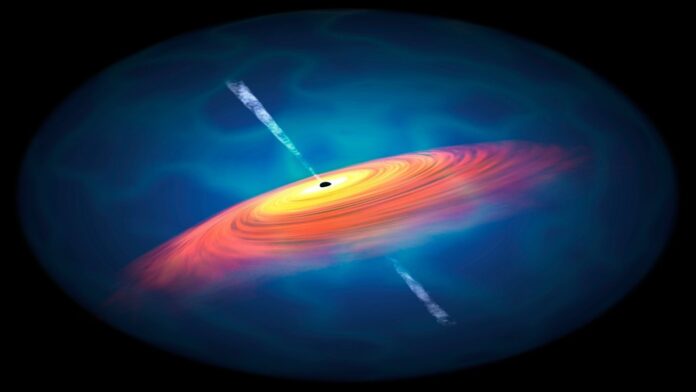Supermassive black holes (SMBHs)—black holes with masses surpassing a million times that of the sun—are known to prevail in the universe today. There is still some mystery surrounding their formation throughout the past 13.8 billion years of the universe.
Recent observations have shown that every galaxy contains a supermassive black hole at its centre and that the black hole mass is nearly invariably one-thousandth of the mass of the host galaxy. Due to their near proximity, galaxies and SMBHs likely developed at the same time. Since galaxies are the visible universe’s major building blocks, understanding their formation processes depends on learning where SMBHs come from.
The early universe, in which less than a billion years have passed since the Big Bang (the beginning of the universe), holds the answer to solving this problem. The limited speed of light allows us to peer into the past by studying the cosmos at great distances. When the universe was a billion years old or less, did SMBHs already exist? Is it conceivable for a black hole to rapidly amass such a massive mass (over a million solar masses and occasionally approaching billions of solar masses)? In that case, what physical mechanisms and conditions underlie it?
Understanding where SMBHs came from will require further observation and comparison of their features with theoretical model predictions. And to do that, we need to determine precisely where in the sky they are.
For the present investigation, we made use of the Subaru Telescope on Maunakea in Hawaii. Subaru’s widefield observing capabilities are one of its greatest strengths and make it ideal for our research. We sought out quasars, a subset of SMBHs with bright peripheries caused by the gravitational energy released by falling matter, because SMBHs themselves do not produce visible light.
In the early universe, we found 162 quasars after surveying a region of the sky 5,000 times larger than the full moon. For instance, 22 of them originated from the most ancient time when quasars were detected (when the universe was less than 800 million years old).
Thanks to the vast number of quasars we found, we were able to calculate the most fundamental measure, the “luminosity function,” which represents the space density of quasars as a function of radiation energy. While the overall shape of the luminosity function changed little over time (apart from the amplitude), we discovered that quasars formed quickly in the early cosmos.
Insightful restrictions on theoretical models that could one day duplicate all the observables and characterise the origin of SMBHs are provided by the luminosity function’s signature behaviour. The study is published in the The Astrophysical Journal Letters.
However, it was known that early on in the universe’s history, a significant phase transition known as “cosmic reionization” occurred. According to previous observations, this phenomenon ionised the entirety of intergalactic space. Although the origin of the ionisation energy is still up for debate, quasar radiation is often cited as a possible explanation.
We found that quasars in the early universe produced 1028 photons per second in a volume of 1 light year by integrating the luminosity function given above. This is less than 1% of the photons required to keep the intergalactic space ionised at that time, suggesting that quasars contributed very little to the reionization of the cosmos. Other energy sources are urgently needed, and recent findings suggest that the combined radiation from big hot stars in galaxies in formation could provide this.
Reference:
Yoshiki Matsuoka et al, Quasar Luminosity Function at z = 7, The Astrophysical Journal Letters (2023). DOI: 10.3847/2041-8213/acd69f
